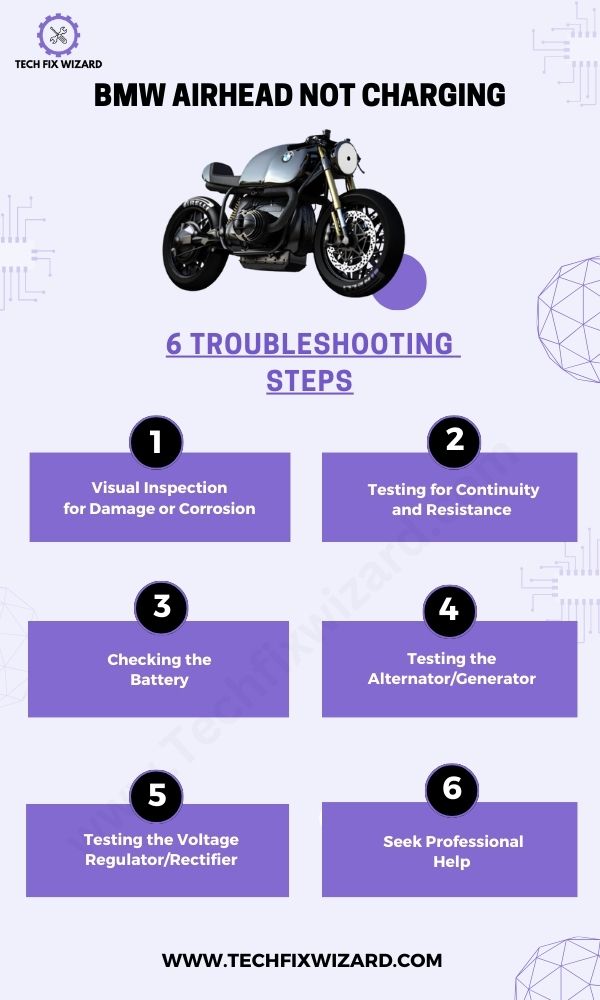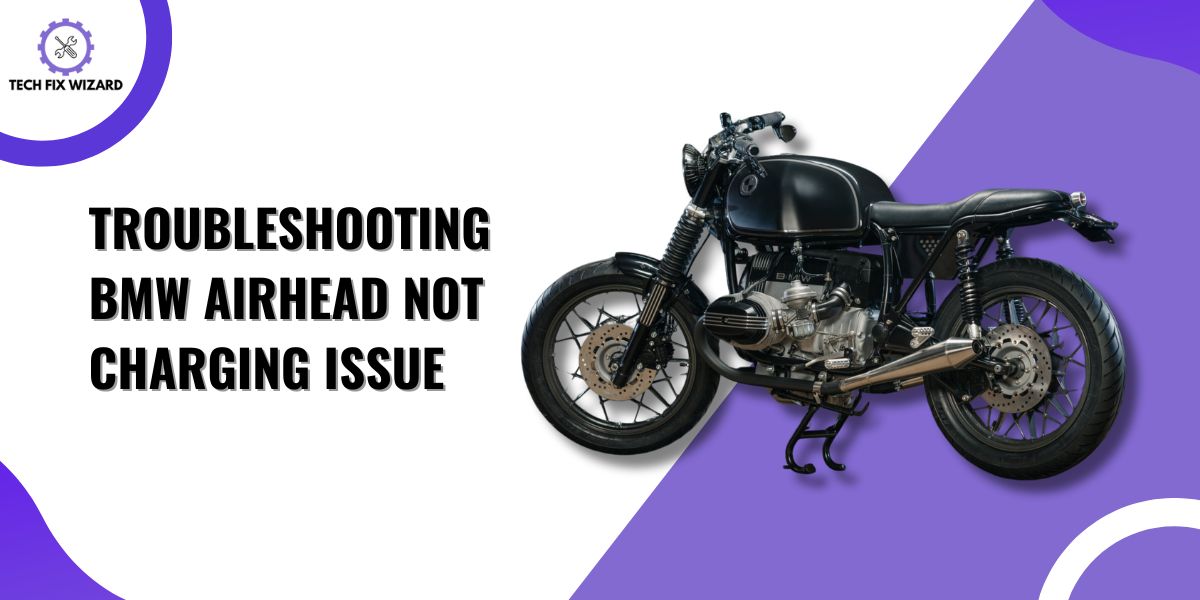Are you experiencing the BMW Airhead not charging issue? It’s a frustrating problem, but fortunately, it’s one that can be fixed.
In this article, we’ll guide you through the step-by-step process of diagnosing and repairing your BMW Airhead’s charging system.
Contents
- 1 5 Common Symptoms of BMW Airhead Not Charging
- 2 6 Troubleshooting Steps to Fix BMW Airhead Not Charging
- 3 1. Visual Inspection for Damage or Corrosion
- 4 2. Testing for Continuity and Resistance
- 5 3. Checking the Battery
- 6 4. Testing the Alternator/Generator
- 7 5. Testing the Voltage Regulator/Rectifier
- 8 6. Seek Professional Help
- 9 Preventative Maintenance Tips for Your BMW Airhead
- 10 FAQs
- 11 1. What are the common symptoms of a BMW Airhead not charging?
- 12 2. What could be causing the charging issue on my BMW Airhead?
- 13 3. How do I test if my alternator/generator is working properly?
- 14 4. How can I check the voltage regulator’s functionality?
- 15 5. What is the typical lifespan of an alternator on a BMW Airhead?
- 16 6. Can a damaged battery cause charging issues?
- 17 7. Are there any specific maintenance tasks to prevent charging problems?
- 18 8. Can a faulty rectifier cause charging problems on my BMW Airhead?
- 19 9. Can a stator failure result in charging problems?
- 20 10. Is it safe to ride my BMW Airhead if it’s not charging the battery?
- 21 11. Should I attempt to repair the charging system myself?
- 22 Official References & Resources
5 Common Symptoms of BMW Airhead Not Charging
Before delving deep into the troubleshooting steps, it’s important to understand the common symptoms associated with the charging problem.
| Symptom | Description | |
|---|---|---|
| 1. | Dimming headlights and electrical accessories | The lights and electrical components (e.g., instrument panel, indicators) may lose brightness or flicker while the engine is running. |
| 2. | Low battery voltage | The battery voltage is below the normal operating range, indicating insufficient charging.
This can lead to a weak or dead battery. |
| 3. | Difficulty starting the motorcycle | Due to insufficient charge in the battery, the motorcycle may struggle to start or fail to start altogether. |
| 4. | Warning lights or indicators | Dashboard warning lights or indicators related to the charging system (e.g., battery light) may illuminate while riding. |
| 5. | Multimeter testing for voltage output | A multimeter is used to measure the charging system’s voltage output, revealing if the alternator/generator is functioning correctly. |
6 Troubleshooting Steps to Fix BMW Airhead Not Charging
Below are the 6 steps that can help you quickly identify the root cause of the problem and, in many cases, even resolve it yourself.
1. Visual Inspection for Damage or Corrosion
Start your troubleshooting process by visually inspection for damage and corrosion.
- Carefully examine all wiring harnesses, cables, and connectors in the charging system.
- Look for any visible signs of damage, such as frayed wires, cuts, or exposed metal.
- Check for signs of corrosion on connectors and terminals, which may appear as greenish or white deposits.
- Inspect the insulation on wires for any cracks or deterioration.

2. Testing for Continuity and Resistance
After visual inspection, it’s time to test the continuity and resistance in the charging system.
- Set the multimeter to continuity test mode (usually denoted by a diode symbol).
- Touch one multimeter probe to one end and the other probe to the opposite end of the wire or connector.
- A continuous beep or low resistance reading indicates good electrical continuity.
- No continuity or high resistance suggests a broken or faulty connection.
- For resistance testing, set the multimeter to resistance (ohms) mode.
- Connect the probes to each end of the wire or connector and note the resistance reading.
- Compare the reading to the manufacturer’s specifications on the owner’s manual for potential issues.
You Might Like: BMW R80 Not Charging – 9 Steps To Follow
3. Checking the Battery
The next step in the troubleshooting BMW Airhead not charging issue is to check the battery by inspecting it visually and testing its voltage.
1. Visual Inspection:
- Examine the battery for any physical damage, leaks, or bulging.
- Ensure the battery terminals are clean and free from corrosion.
- Check the battery cables for tightness and secure connections.
2. Battery Voltage Testing:
- Turn off the motorcycle’s engine and all electrical accessories.
- Connect the voltmeter’s positive (red) probe to the battery’s positive terminal (+) and the negative (black) probe to the negative terminal (-).
- Read the voltage displayed on the voltmeter.
- A fully charged battery should read around 12.6 to 12.8 volts.
- If the voltage is significantly lower, it may indicate a partially discharged or weak battery.
- Recharge the battery if needed and retest its voltage.

People Also Like: BMW R1200GS Not Charging – 5 Quick & Easy Steps To Follow
4. Testing the Alternator/Generator
If you ruled out any battery-related issues then it is a good time to go for testing the alternator/generator on your BMW Airhead;
- Locating the alternator on the left side of the engine.
- Disconnecting the green and black wires’ electrical connectors.
- Using a digital multimeter set to AC voltage mode.
- Measuring the AC voltage output (25-30 volts) at idle RPM.
- Gradually increasing RPM and ensuring voltage rises proportionally.
5. Testing the Voltage Regulator/Rectifier
| Step | Description |
|---|---|
| 1. | Start the motorcycle’s engine and let it idle. |
| 2. | Use a voltmeter set to DC voltage mode. |
| 3. | Locate the voltage regulator/rectifier (usually near the battery or under the seat). |
| 4. | Identify the three wires connected to the regulator/rectifier (usually yellow or white). |
| 5. | Connect the voltmeter’s positive (red) probe to one of the yellow or white wires. |
| 6. | Connect the voltmeter’s negative (black) probe to the motorcycle’s frame or ground. |
| 7. | Note the voltage reading displayed on the voltmeter. |
| 8. | Gradually increase the engine RPM while observing the voltmeter. |
| 9. | The voltage reading should increase steadily and stabilize within the manufacturer’s range. |
Also Read: BMW R100 Not Charging – 6 Easy & Quick Steps To Try
Replacing the Voltage Regulator
If after performing the voltage test, you find out the need to replace the voltage regulator in a BMW Airhead motorcycle then follow the steps below:
- Disconnect the battery for safety.
- Locate the voltage regulator near the battery or under the seat.
- Remove the old voltage regulator, and disconnect the electrical connectors.
- Install the new voltage regulator, securing it with bolts.
- Reconnect the battery.
- Test the charging system with a multimeter.
- Verify the proper functioning of all electrical components.
- Double-check connections and fasteners for security.
6. Seek Professional Help
If you have attempted all the troubleshooting steps and testing procedures for the charging system, and still cannot identify or resolve the issue, it may be time to seek professional help.
In such cases, it is best to consult a qualified motorcycle mechanic or a BMW specialist who has experience working with Airhead models.
Professional mechanics have the expertise, knowledge, and diagnostic tools to pinpoint complex charging system problems and ensure accurate and efficient repairs.
Preventative Maintenance Tips for Your BMW Airhead
Maintaining your BMW airhead regularly is crucial for ensuring its longevity and optimal performance.
One of the most important preventative maintenance tips is to keep your battery in good condition. This means:
- Checking the electrolyte levels and topping them up as needed, as well as keeping the terminals clean and free from corrosion.
- Maintaining your BMW airhead is regularly checking all electrical connections and wiring.
- Performing regular oil changes and tune-ups on your BMW airhead.
Our Popular Posts:
- BMW F800GS Battery Not Charging – 7 Steps To Try
- BMW R65 Battery Not Charging – 7 Troubleshooting Steps
FAQs
1. What are the common symptoms of a BMW Airhead not charging?
Dim or flickering lights, rapidly draining battery, difficulty starting the bike, and discharged battery even after riding for a while.
2. What could be causing the charging issue on my BMW Airhead?
Possible causes include a faulty alternator or generator, defective voltage regulator, broken or loose wires, and worn-out brushes in the generator.
3. How do I test if my alternator/generator is working properly?
Use a multimeter to check voltage output across the battery terminals while the engine is running.
You should read a voltage higher than the battery’s voltage (around 13-14V).
4. How can I check the voltage regulator’s functionality?
With the engine running, use a multimeter to measure the voltage at the regulator’s input and output terminals.
The output voltage should be within the manufacturer’s specified range.
5. What is the typical lifespan of an alternator on a BMW Airhead?
Depending on usage and maintenance, alternators can last anywhere from 50,000 to 100,000 miles or more.
6. Can a damaged battery cause charging issues?
Yes, a defective battery can interfere with the charging system’s performance and should be tested and replaced if necessary.
7. Are there any specific maintenance tasks to prevent charging problems?
Regularly inspect and clean the battery terminals, check and tighten all electrical connections and grounds, and keep the alternator’s cooling fins clean and unobstructed.
8. Can a faulty rectifier cause charging problems on my BMW Airhead?
Yes, a malfunctioning rectifier can disrupt the proper flow of current from the alternator to the battery, leading to charging issues.
9. Can a stator failure result in charging problems?
Yes, a failing stator (part of the alternator) can lead to insufficient charging or no charging at all.
10. Is it safe to ride my BMW Airhead if it’s not charging the battery?
No, riding with a discharged battery can lead to a sudden breakdown if the bike loses all electrical power. It is not safe, and you should resolve the issue before riding.
11. Should I attempt to repair the charging system myself?
If you have the necessary mechanical and electrical knowledge, you can attempt basic checks like inspecting connections and testing the battery and fuses.
However, complex issues may require professional assistance from a skilled motorcycle mechanic.
Official References & Resources
Our research for accurate information about BMW involved a thorough analysis of official resources, including the official BMW website owner’s manuals, technical specifications, and relevant support forums.
Our research and data gathering involved thorough analysis of the official websites, including:

John Paul is a tech enthusiast dedicated to troubleshooting. He is passionate about fixing glitches, simplifying complexities, and empowering others in the digital realm.

